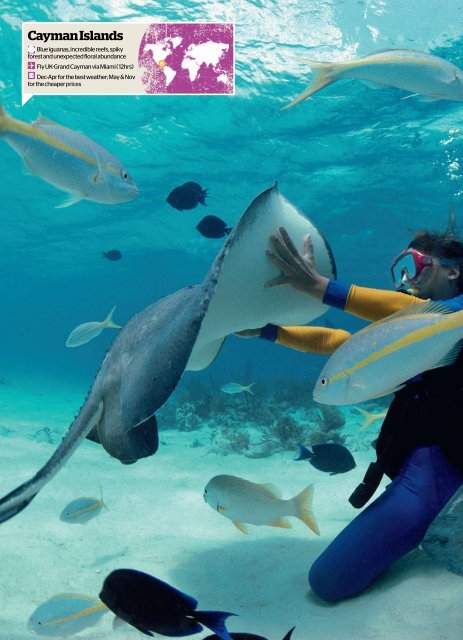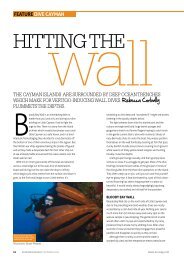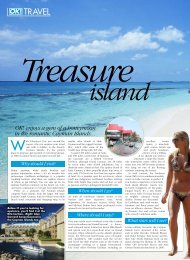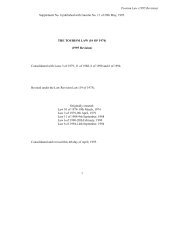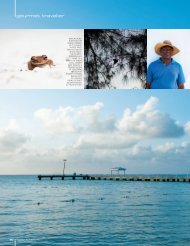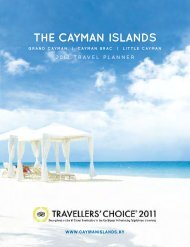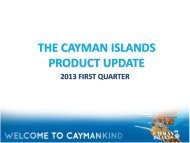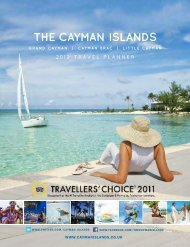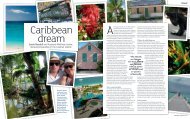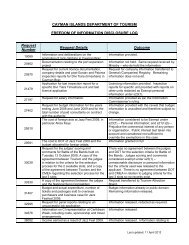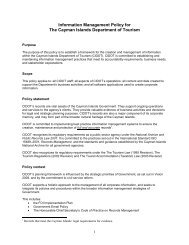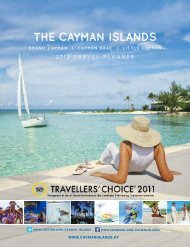You also want an ePaper? Increase the reach of your titles
YUMPU automatically turns print PDFs into web optimized ePapers that Google loves.
1<br />
I<br />
I 1<br />
I 1<br />
I<br />
<strong>Cayman</strong> <strong>Islands</strong><br />
I<br />
1<br />
I 1<br />
Blue iguanas, incredible reefs, spiky<br />
forest and unexpected floral abundance<br />
Fly UK-Grand <strong>Cayman</strong> via Miami ( 12hrs)<br />
Dec-Apr for the best weather; May & Nov<br />
for the cheaper prices<br />
©
<strong>Treasure</strong><br />
<strong>Islands</strong><br />
The <strong>Cayman</strong> <strong>Islands</strong>: just a pretty tax haven, right? Wrong. This idyllic<br />
Caribbean trio has prolific and wonderful wildlife both on and off shore<br />
Words James Stewart<br />
“Like fishy wet lino”<br />
Close encounters with<br />
stingrays at Southern City,<br />
Grand <strong>Cayman</strong>
<strong>Cayman</strong> <strong>Islands</strong><br />
Clockwise from<br />
this image<br />
The endangered blue<br />
iguanas change from<br />
grey to blue, depending<br />
on temperature; the<br />
pygmy blue butterfly is<br />
the world’s smallest;<br />
<strong>Cayman</strong> has more flora<br />
species than the<br />
Galápagos, including<br />
wild jasmine; George<br />
Town is <strong>Cayman</strong>’s only<br />
real ‘town’; around 350<br />
<strong>Cayman</strong> parrots remain<br />
on Brac; the small green<br />
anole lizard is also able<br />
to change colour<br />
here are plenty of<br />
T<br />
easy ways to strike<br />
up a conversation<br />
on Grand <strong>Cayman</strong><br />
– drive to North<br />
Side district and<br />
pull up a bar stool<br />
at Over The Edge restaurant, perhaps. But I<br />
chose to do it one heroically stupid way...<br />
It was a beautiful afternoon in a botanic<br />
park made treacly by heat and tropical<br />
flowers. A teenager, pointed out to me<br />
earlier as Ruth, caught my attention and<br />
nodded; she was steely-eyed and exotic. I<br />
returned the greeting and she sidled closer.<br />
She nodded again. Flattered, I returned the<br />
compliment. She studied me, yawned, then<br />
sauntered into the vegetation: my first chat<br />
in the argot of the Grand <strong>Cayman</strong> blue<br />
iguana and it turns out I am a crushing bore.<br />
Is anywhere in the Caribbean so maligned<br />
as the <strong>Cayman</strong> <strong>Islands</strong>? Here it is, a tropical<br />
destination with wildlife like B-movie<br />
monsters and all outsiders want to talk<br />
about is taxes. So, let’s deal with the<br />
awkward facts first. The <strong>Cayman</strong> <strong>Islands</strong> –<br />
Grand <strong>Cayman</strong>, <strong>Cayman</strong> Brac and Little<br />
<strong>Cayman</strong>, often known collectively as<br />
<strong>Cayman</strong>, never the <strong>Cayman</strong>s – are the<br />
world’s fifth-largest banking centre and its<br />
leading offshore hedge fund jurisdiction.<br />
Six corporations are listed for each of the<br />
islands’ 50,000 residents.<br />
George Town – the only town worth the<br />
name – harbours the financial centre but its<br />
heart isn’t in it. A Florida-lite of mirrored<br />
low-rises and clapperboard giftshops, it is<br />
built on Caribbean time and warm sea<br />
breezes. Feral chickens scratch among the<br />
officeblocks. Just across the main road is<br />
spectacular Seven Mile Beach, the only<br />
tourist resort on the island.<br />
Blue is beautiful<br />
The tax-free status of this British Overseas<br />
Territory dates back to Oliver Cromwell’s<br />
effort to lure settlers. Yet if history suggests<br />
anything, it’s that these islands are more<br />
nature haven than the tax haven they<br />
became in the mid-1980s. Columbus wrote<br />
about seas so full of turtles he could<br />
practically walk ashore, and the islands<br />
took their name from caiman crocodiles.<br />
Nowadays <strong>Cayman</strong> has more species of<br />
flora than the Galápagos, including three<br />
orchids found nowhere else. New species are<br />
found regularly, botanist Ann Stafford<br />
explained as we walked through one of the<br />
Local view<br />
Alberto, Blue Iguana<br />
Reserve warden<br />
“The east is authentic<br />
Grand <strong>Cayman</strong>. Walk,<br />
take your time and you’ll<br />
see parrots, nature,<br />
proper Caribbean stuff<br />
you’ll see nowhere else.<br />
And you have to come<br />
and see us, of course.”<br />
Caribbean’s last undisturbed subtropical<br />
forests. We were on the Mastic Trail, which<br />
cuts across the east of the island, an empty<br />
green space on my map. Ann pointed out<br />
flora such as bloody head-raw bones and red<br />
birch, whose peeling bark leads <strong>Cayman</strong>ians<br />
to nickname it the ‘tourist tree’. We paused<br />
at a spindly shrub: Casearia staffordiae, one<br />
Ann had discovered herself.<br />
The fascination of <strong>Cayman</strong> is its interplay<br />
of nature and culture, Ann told me. “Plants<br />
are part of the identity of these islands; they<br />
make them unique. We don’t have large<br />
animals but because of these plants we have<br />
an interesting diversity of wildlife.”<br />
The world’s smallest butterfly, the pygmy<br />
blue, was presumed extinct until it turned<br />
up in Grand <strong>Cayman</strong> in 2002. Over 180 bird<br />
species make merry carnival in the canopy.<br />
And then there are those iguanas.<br />
A decade ago, all but a dozen blue iguanas<br />
had been swept away by bush clearances,<br />
cars, feral cats and local farmers who<br />
resented their taste for mangos. The species<br />
would probably have become extinct were it<br />
not for an expat National Trust officer who<br />
founded the Blue Iguana Recovery Program<br />
two decades ago.<br />
In the Queen Elizabeth II Botanic Park,<br />
head warden John Marotta showed me the<br />
breeding pens like a proud father: there was<br />
25-year-old Vegas with his teenage bride,<br />
Forrest; there was Billy and Deborah – she<br />
was about to lay. Some reptiles are aloof,<br />
others are sociable. He caught himself: ><br />
Previous spread: Corbis. This spread: Will Burrard-Lucas / <strong>Cayman</strong> <strong>Islands</strong> Department of Tourism; Doc Poulson<br />
86 | Wanderlust December 2012/January 2013
‘Some iguanas are aloof, some sociable:<br />
each animal has its own personality’
‘There are over 100 wrecks to explore,<br />
from 18th-century merchant barques to<br />
the USS Kittiwake off Seven Mile Beach’
Dreamstime; Getty<br />
<strong>Cayman</strong> <strong>Islands</strong><br />
Fearsome fish<br />
Lionfish can poison<br />
people and destroy<br />
coral reefs<br />
“I don’t usually anthropomorphise but each<br />
animal really has a personality, more so than<br />
a dog. Never would have thought I’d say that<br />
when I came here five years ago.”<br />
The iguanas’ party trick is to change from<br />
dirty grey to powder-blue according to body<br />
temperature and mating season. They also<br />
have baby-fat folds over clumpy feet and<br />
slow movements. If anything, they resemble<br />
clockwork dinosaurs. I was smitten.<br />
Ruth – my first encounter – is one of the<br />
breeding programme’s successes. Around<br />
600 iguanas have been released since 2009;<br />
bred from a gene pool structured for<br />
diversity, the reptiles are nurtured in<br />
captivity for two years until old enough to be<br />
safe from predators. Today, 50 blue iguanas<br />
potter around the park grounds; 600 more<br />
stalk two reserves in east Grand <strong>Cayman</strong>. No<br />
one is celebrating just yet – scientists suggest<br />
over 1,000 wild animals are needed to be on<br />
the safe side of genetic diversity – but there is<br />
steady progress. If only more people cared<br />
about <strong>Cayman</strong> wildlife, John sighs.<br />
Shooting fish<br />
Visitors are not entirely ignorant of local<br />
fauna. Teetering on the edge of a 7.5km void<br />
where the Caribbean and North American<br />
tectonic plates meet, these islands are loved<br />
by divers. Reefs are a carnival of neon-lit<br />
shrimps and molluscs frilled like Regency<br />
dandies. Carousels of fish whirl around<br />
coralheads and turtles scull in the shallows.<br />
There are over 100 wrecks to explore, from<br />
18th-century merchant barques to the 80m<br />
USS Kittiwake scuttled last year off Seven<br />
Mile Beach. A dream-like swim through<br />
cabins bathed in slippery light as barracuda<br />
cruise past portholes, it is already the<br />
Caribbean’s premier wreck dive.<br />
You don’t even have to swim to have a close<br />
encounter of the aquatic kind. There’s a<br />
sandbar a mile offshore called Stingray City.<br />
Fishermen once cleaned their nets in its<br />
waist-deep shallows. Now all it takes is the<br />
sound of a boat’s engine to attract stingrays<br />
the size of kitchen tables. Like being ><br />
Wanderlust December 2012/January 2013 | 89
<strong>Cayman</strong> <strong>Islands</strong><br />
‘Frigate birds hovered on bent wings like<br />
smothered in fishy wet lino, it is the weirdest<br />
wildlife encounter in the Caribbean.<br />
Given that <strong>Cayman</strong>’s biblical motto – ‘He<br />
hath founded it upon the sea’ – sums up its<br />
tourism strategy, it was a fright when a red<br />
lionfish was discovered here in May 2008.<br />
Six breeding pairs capable of producing<br />
500,000 young a year each were accidentally<br />
released from a Miami aquarium in 1994,<br />
and the Indo-Pacific super-predator had<br />
chomped its way along the Caribbean chain,<br />
guzzling native fry and the grazers that<br />
checked algae on coral. Marine biologists<br />
speculate lionfish may be more catastrophic<br />
than climate change for the region’s reefs.<br />
At the fish market in George Town<br />
(actually, just a few stalls on the beach) there<br />
was no doubt about the scale of the invasion.<br />
“I been fishing ’ere for 43 years and even five<br />
years ago, nothing,” said one fisherman.<br />
“Now every coralhead, they’re there, man.<br />
Charles” – he gesticulates to a guy in<br />
salt-bleached shorts – “he got one that were<br />
14in; about 4lb.”<br />
Charles shrugged: “Every one I catch is<br />
one I stop my son seein’.”<br />
“Yeah man, but that’s a big fish – ’im<br />
proper dangerous.”<br />
Ah yes, danger. Pterois volitans is not just<br />
one of the most adaptable fish in the world,<br />
it is also one of most venomous. The poison<br />
from its 18 feathery spines can induce<br />
delirium, breathing issues, even paralysis.<br />
Every satisfying wildlife adventure should<br />
provide a remote possibility of death or<br />
injury, I told myself as I signed the waiver to<br />
join a lionfish cull with dive operator<br />
Divetech. To combat the threat of lionfish,<br />
the <strong>Cayman</strong> government repealed an<br />
outright ban on spear-fishing for trained<br />
divers. Now dive centres run weekly hunts<br />
and anyone with a PADI licence can tag<br />
along as a spotter.<br />
For a novice diver like me, the hour-long<br />
dive is a bargain at US$10. And when sold in<br />
Local view<br />
Keino, wildlife guide, <strong>Cayman</strong> Brac<br />
“Get to know the locals. It takes no effort<br />
cos everyone is really eager to help – I<br />
sometimes think they love tourists more<br />
than islanders. They’ll help you, take care<br />
of you, bring you a fish. It’s a Brac thing.”<br />
Foster’s Food Fair supermarket, our catch<br />
will fund future hunts. It’s a win-win for<br />
everyone – except the lionfish, of course.<br />
At Parson’s Reef I dropped overboard with<br />
Divetech’s Jeni Chapman, who held a spear<br />
in one hand. Flanked by armed divers, I felt<br />
like an extra in a James Bond movie. Jeni<br />
finned off so, spying a narrow channel, I<br />
kicked towards it, scouting beneath the<br />
coralheads where lionfish lurk.<br />
The trouble was, distractions were<br />
everywhere. Blue angelfish drifted among<br />
the seafans. Under ledges there were scarlet<br />
squirrelfish and lobsters, groupers and<br />
gobies. I turned to see Jeni stab beneath<br />
an overhang then thrust her spear into<br />
a cylindrical fish-tank, depositing a large<br />
lionfish. I could have sworn it looked furious.<br />
No thanks to me, we surfaced an hour later<br />
with 26 fish for the deli counter. Once over<br />
the quiet elation at getting away scratch-free,<br />
what surprised me was how protective I felt<br />
toward the reefs. “I am the most placid<br />
person you could meet,” Jeni agreed, “and<br />
now I’m an expert at slaughtering fish. But<br />
these culls really work – we see tangible<br />
results.” She adds sotto voce: “They’re also<br />
a little bit fun.”<br />
The island before time<br />
The next day I soar over those seas – palest<br />
aqua then azure, royal blue and blue-black –<br />
Will Burrard-Lucas / <strong>Cayman</strong> <strong>Islands</strong> Department of Tourism; Getty; James Stewart<br />
90 | Wanderlust December 2012/January 2013
pterodactyls: it felt like the dawn of time’<br />
on a Twin Otter bound for <strong>Cayman</strong> Brac.<br />
With a population of just 2,000, it makes<br />
George Town feel like Miami. Return the car<br />
anywhere outside the airport and leave the<br />
keys inside, the hire company manager<br />
instructed me. Locked? I asked. “Nah, man;<br />
open’s fine. This is the Brac.”<br />
I barely used the car. Every visitor to<br />
<strong>Cayman</strong> Brac receives a free personal tour<br />
with a government nature guide; mine,<br />
Keino, was happy to show me the sights<br />
for as long as I liked.<br />
‘Brac’ in Gaelic refers to the ‘bluff’ of<br />
limestone that gives this 19km-long island<br />
its unusually rugged good looks. We circuit<br />
its impressive slab, peering at bats in caves<br />
and pottering on lanes while Keino chats<br />
about island culture. He mentions the<br />
birdlife, and adds that no species is more<br />
prized among spotters than the <strong>Cayman</strong><br />
Brac parrot. And so began our wild parrot<br />
chase. With a sprightly septuagenarian<br />
birder called Wallace, we followed old<br />
fishermen’s footpaths in the National<br />
Trust-owned Brac Parrot Reserve.<br />
Wallace happily recounted past exploits in<br />
search of the 350 remaining birds and stared<br />
intently at the mango trees where parrots<br />
feed. There was a flicker of excitement in the<br />
Christopher Columbus Park when a rasp in<br />
the canopy answered Wallace’s call but our<br />
parrot was shy.<br />
Local view<br />
Mike, iguana guide,<br />
Little <strong>Cayman</strong><br />
“Many people visit and<br />
only dive or think they<br />
have everything in a<br />
resort. Take a bike and<br />
see the island for what<br />
it really is: see its nature,<br />
its wild orchids and<br />
its tranquillity.”<br />
I was disappointed – until we drove to the<br />
80m cliffs of the eastern tip. Silver-thatch<br />
palms, the national tree of <strong>Cayman</strong>, burst<br />
above thick wild jasmine and the sky and sea<br />
busted the horizon on every side. Hundreds<br />
of brown boobies nursed puffball chicks on<br />
cliff-edge nests while frigate birds hovered<br />
on bent wings like pterodactyls.<br />
“This part has probably changed least<br />
since Columbus came,” Wallace said. Only<br />
500 years? It felt like the dawn of time.<br />
Unprotected idyll<br />
Little <strong>Cayman</strong> is wilder still. Ten minutes<br />
away on the Twin Otter, it is the same size as<br />
Brac but has just 150 inhabitants. Its airport<br />
is a large shed whose sign reads ‘Terminal A,<br />
Gate 1’; ‘Town’ is barely a hamlet.<br />
Elsewhere all is swathes of undisturbed<br />
spiky green. I spent most of my time<br />
Bird heaven<br />
Booby Pond Nature Reserve,<br />
Little <strong>Cayman</strong>, is home to a third<br />
of the entire Caribbean and<br />
Atlantic population of<br />
red-footed boobies (see left)<br />
barefoot on a bike, zigzagging one-handed<br />
along empty roads.<br />
What Little <strong>Cayman</strong> has in abundance is<br />
wildlife. Around 20,000 red-footed boobies<br />
squawk in and around Booby Pond and<br />
Jamaican whistling ducks flute in lagoons.<br />
Hawksbill turtles nest on dazzling-white<br />
beaches and there’s astonishing diving where<br />
Bloody Bay Wall drops into inky depths.<br />
The island has its own iguana, too: the<br />
Sister Isles rock iguana, virtually extinct on<br />
Brac. The 1,000-odd reptiles have the right of<br />
way on roads I learned on another free tour.<br />
My guide, Mike, a dreadlocked Floridian,<br />
came on an iguana conservation programme<br />
and never left. “Only 4% of this island is<br />
developed,” he told me. “That’s incredible so<br />
close to the US. Yet it’s also worrying: there’s<br />
no protection for the other 96%.”<br />
I was surprised a destination so protective<br />
of its marine environment seemed so<br />
indifferent to land use. But then I realised<br />
it may be because us outsiders also have a<br />
blind spot. Marine parks are created because<br />
people want to visit them. No one sees these<br />
islands as a place to experience tropical<br />
forests or wild beaches where turtles breed.<br />
Mike turned down a dirt-track. There<br />
was nothing around us but silvery palms,<br />
wild jasmine and orchids that exploded like<br />
popcorn. An iguana dozed nearby. Not quite<br />
no one, I thought. ■<br />
Wanderlust December 2012/January 2013 | 91
<strong>Cayman</strong> <strong>Islands</strong><br />
Footnotes<br />
VITAL STATISTICS<br />
Capital: George Town, Grand <strong>Cayman</strong><br />
Population: 53,000<br />
Language: English<br />
Time: GMT-5<br />
International dialling code: +345<br />
Visas: Not required by UK nationals<br />
Money: <strong>Cayman</strong> <strong>Islands</strong> dollar (CI$),<br />
currently CI$1.3 to the UK£. US dollars<br />
universally accepted. There is only one ATM<br />
each on <strong>Cayman</strong> Brac and Little <strong>Cayman</strong>.<br />
When to go<br />
Jan Feb Mar Apr May Jun<br />
Jul Aug Sept Oct Nov Dec<br />
■ Winter is high season: temperatures<br />
average 78°C, trade winds are cool, humidity<br />
is low – mid-Dec to early January and April<br />
are peak times. The flip side is higher prices<br />
and crowds around Seven Mile Beach.<br />
■ Shoulder season: temperatures and<br />
humidity increase from winter, prices lower.<br />
■ Summer; temperatures average 86°C.<br />
High humidity often produces tropical<br />
downpours, though these clear quickly.<br />
Strong winds in August-September can<br />
affect diving visibility. Although rare and<br />
well-forecasted, hurricanes are possible.<br />
Health & safety<br />
There are no big health issues.<br />
Grand <strong>Cayman</strong> has the most comprehensive<br />
healthcare facilities; medicines are tricky to<br />
source on <strong>Cayman</strong> Brac and Little <strong>Cayman</strong>.<br />
Further reading<br />
& information<br />
<strong>Cayman</strong> <strong>Islands</strong> (Bradt, 2008)<br />
Diving & Snorkelling <strong>Cayman</strong> <strong>Islands</strong><br />
(Lonely Planet, 2007)<br />
Dive <strong>Cayman</strong> <strong>Islands</strong> (New Holland, 2007)<br />
The Little Blue Book: A short history of the<br />
Grand <strong>Cayman</strong> Blue Iguana (International<br />
Reptile Conservation Foundation, 2010)<br />
by Frederic J Burton<br />
www.caymanislands.co.uk<br />
More online<br />
Visit www.wanderlust.co.uk/132<br />
for links to more content:<br />
Archive articles<br />
Offbeat Caribbean travel blueprint –<br />
issue 106, Oct 09<br />
10 great snorkelling destinations –<br />
online, Jan 11<br />
Planning guides<br />
<strong>Cayman</strong> <strong>Islands</strong> travel guide<br />
Caribbean travel guide<br />
The trip<br />
Barefoot Traveller (020 8741 4319,<br />
barefoot-traveller.com) offers seven-night<br />
dive trips on Grand <strong>Cayman</strong> from £1,850pp,<br />
including flights, accommodation at Cobalt<br />
Coast Dive Resort, daily boat dives, unlimited<br />
shore dives and a lionfish cull.<br />
Lionfish culls run weekly; see www.<br />
dive365cayman.com/lionfish. Blue Iguana<br />
Safaris run at 11am daily, except Sundays<br />
(CI$24 [£18]; www.blueiguana.ky).<br />
Ann Stafford runs half-day nature tours<br />
(CI$240 [£184]; www.caymannature.ky).<br />
Getting there<br />
BA (0844 493 0787, ba.com) and<br />
American Airways (0844 499 7300, aa.com)<br />
fly Heathrow-Grand <strong>Cayman</strong> via Miami<br />
from £650 return. Flight time is 11-13hrs.<br />
Getting around<br />
<strong>Cayman</strong> Airways (caymanairways.<br />
com) flies several times daily between Grand<br />
<strong>Cayman</strong>, <strong>Cayman</strong> Brac and Little <strong>Cayman</strong>;<br />
flights from Grand <strong>Cayman</strong> to Brac/Little<br />
take 50mins; singles cost from CI$65 (£48).<br />
Nine bus routes cross Grand <strong>Cayman</strong>;<br />
fares start at CI$1.50 (£1.12). A car or scooter<br />
Cost 9 of travel<br />
Doubles 10 in high season on Grand<br />
<strong>Cayman</strong> cost from CI$115 (£86), less on other<br />
islands. Food at a roadside grill costs around<br />
CI$6 (£4.50); mains at a mid-range restaurant<br />
from CI$18 (£13.50). A Caybrew Beer costs<br />
CI$4 (£3).<br />
<strong>Cayman</strong> <strong>Islands</strong>: Top 10 Natural Highlights<br />
1. Mastic Trail A 4km hike through the<br />
forest of Grand <strong>Cayman</strong>’s Little spiky <strong>Cayman</strong> centre<br />
2. USS Kittiwake The Caribbean’s<br />
newest and most impressive wreck dive<br />
3. Stingray City Touristy but<br />
memorable aquatic encounter<br />
4. Blue Iguana Recovery<br />
Program The easiest way to see<br />
<strong>Cayman</strong>’s enigmatic signature species<br />
5. Rum Point Beach, bars and<br />
hammocks – a popular Sunday outing<br />
for locals on Grand <strong>Cayman</strong><br />
2<br />
USS<br />
Kittiwake<br />
Seven Mile<br />
Beach<br />
GEORGE<br />
TOWN<br />
Stingray<br />
City<br />
3<br />
East End<br />
with caves by the road beneath<br />
Point<br />
O’Sand 7. Brac Parrot Reserve Spot parrots (if<br />
Christopher<br />
you’re lucky) and Columbus ocean Parkviews at the trail’s end<br />
<strong>Cayman</strong> Brac<br />
Rum Point<br />
is the best way to explore Grand <strong>Cayman</strong> or<br />
<strong>Cayman</strong> Brac. Cycling is standard on Little<br />
<strong>Cayman</strong>; all hotels offer free bike hire.<br />
Accommodation<br />
The Retreat Lookout (Grand <strong>Cayman</strong>;<br />
retreatatlookout.com) is an authentic<br />
agritourism B&B; doubles from US$90.<br />
Walton’s Mango Manor (<strong>Cayman</strong> Brac;<br />
waltonsmangomanor.com) is a relaxing<br />
colonial-style B&B; doubles from US$105.<br />
Quirky Pirates Point (Little <strong>Cayman</strong>;<br />
piratespointresort.com) offers week-long<br />
dive packages in airy villas from US$1,895pp.<br />
Food & drink<br />
Typical <strong>Cayman</strong> food is a taste of the<br />
Caribbean: conch, fish, coconut, mango,<br />
plantain, rice and peas. Try local rums such<br />
as Seven Fathoms, aged underwater. ■<br />
6. East End Birdlife and views on Brac's cliffs,<br />
8. Bloody Bay Wall Sharks and eagle rays<br />
on a 1,500m drop-off, just off Little <strong>Cayman</strong><br />
9. Point O’ Sand Perfect Little <strong>Cayman</strong> beach:<br />
pink-white sand, shallow turquoise water and<br />
nothing else<br />
10. Owen Island Kayak to this textbook<br />
Caribbean castaway idyll off Little <strong>Cayman</strong><br />
5<br />
Grand <strong>Cayman</strong><br />
Little <strong>Cayman</strong><br />
8<br />
10<br />
1<br />
Point<br />
O’Sand<br />
Christopher<br />
9<br />
Columbus Park<br />
<strong>Cayman</strong> Brac<br />
4<br />
7<br />
Blue Iguana<br />
Nature Reserve<br />
Queen Elizabeth II<br />
Botanic Park<br />
East End<br />
6<br />
Stingray<br />
City<br />
CARIBBEAN SEA<br />
Rum Point<br />
0 4km<br />
USS<br />
Kittiwake<br />
Seven Mile<br />
B


